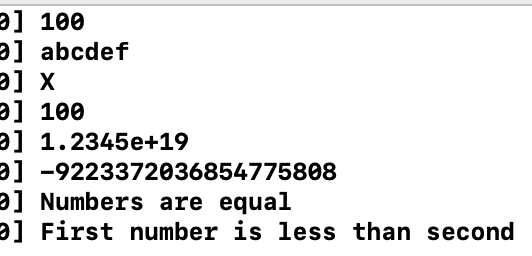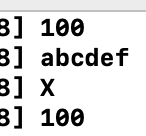NSNumber类
作者:追风剑情 发布于:2019-2-27 17:18 分类:Objective-C
| NSNumber的创建方法和检索方法 | ||
| 创建和初始化方法 | 初始化实例方法 | 检索实例方法 |
| numberWithChar: | initWithChar: | charValue |
| numberWithUnsignedChar: | initWithUnsignedChar: | unsignedCharValue |
| numberWithShort: | initWithShort: | shortValue |
| numberWithUnsignedShort: | initWithUnsignedShort: | unsignedShortValue |
| numberWithInteger: |
initWithInteger: |
integerValue |
| numberWithUnsignedInteger: |
initWithUnsignedInteger: |
unsignedIntegerValue |
| numberWithInt: |
initWithInt: |
intValue |
| numberWithUnsignedInt: |
initWithUnsignedInt: |
unsignedIntValue |
| numberWithLong: |
initWithLong: |
longValue |
| numberWithUnsignedLong: |
initWithUnsignedLong: |
unsignedLongValue |
| numberWithLongLong: |
initWithLongLong: |
longlongValue |
| numberWithUnsignedLongLong: |
initWithUnsignedLongLong: |
unsignedLongLongValue |
| numberWithFloat: |
initWithFloat: |
floatValue |
| numberWithDouble: |
initWithDouble: |
doubleValue |
| numberWithBool: |
initWithBool: |
boolValue |
注意:在Xcode 4.2之前的版本,使用哪个版本的方法是很重要的,有一类方法创建的对象是会自动释放的,然而使用alloc版本创建的对象需要在使用完后自己负责释放(在IOS中)。随着Objective-C中引入了自动引用计数(ARC),已经能够自动处理内存管理,就不再偏向于使用某一类方法。
示例一:
- #import <Foundation/Foundation.h>
- int main(int argc, const char * argv[]) {
- @autoreleasepool {
- NSNumber *myNumber, *floatNumber, *intNumber;
- // NSInteger不是一个对象,而是基本数据类型的typedef。
- // 它实际上是64位的long或者32位的int。NSUInteger也是类似的typedef
- NSInteger myInt;
- // integer 型值
- intNumber = [NSNumber numberWithInteger: 100];
- myInt = [intNumber integerValue];
- NSLog(@"%li", (long) myInt);
- // long 型值
- myNumber = [NSNumber numberWithLong: 0xabcdef];
- NSLog(@"%lx", [myNumber longValue]);
- // char 型值
- myNumber = [NSNumber numberWithChar: 'X'];
- NSLog(@"%c", [myNumber charValue]);
- // float 型值
- floatNumber = [NSNumber numberWithFloat: 100.00];
- NSLog(@"%g", [floatNumber floatValue]);
- // double 型值
- myNumber = [NSNumber numberWithDouble: 12345e+15];
- NSLog(@"%lg", [myNumber doubleValue]);
- // 发生错误
- NSLog(@"%li", (long) [myNumber integerValue]);
- // 验证两个Number是否相等
- if ([intNumber isEqualToNumber: floatNumber] == YES)
- NSLog(@"Numbers are equal");
- else
- NSLog(@"Numbers are not equal");
- // 验证一个Number是否小于、等于或大于另一个Number
- // compare函数的返回值:
- // 小于 返回NSOrderedAscending
- // 等于 返回NSOrderdSame
- // 大于 返回NSOrderedDescending
- if ([intNumber compare: myNumber] == NSOrderedAscending)
- NSLog(@"First number is less than second");
- }
- return 0;
- }
运行测试
示例二:通过@表达式创建数字对象
- #import <Foundation/Foundation.h>
- int main(int argc, const char * argv[]) {
- @autoreleasepool {
- NSNumber *myNumber, *floatNumber, *intNumber;
- NSInteger myInt;
- // 注意:如果在@之后的值是一个表达式或者变量需要使用括号。
- // NSDecimalNumber是NSNumber的子类,在对象层面提供了一些数字的四则运算方法。
- // 整型 integer
- intNumber = @100;
- myInt = [intNumber integerValue];
- NSLog(@"%li", (long) myInt);
- // 长整型 long integer
- myNumber = @0xabcdefL;
- NSLog(@"%lx", [myNumber longValue]);
- // 字符型 char
- myNumber = @'X';
- NSLog(@"%c", [myNumber charValue]);
- // 浮点型 float
- floatNumber = @100.0f;
- NSLog(@"%g", [floatNumber floatValue]);
- }
- return 0;
- }
标签: Objective-C
« NSString类
|
Foundation文档»
日历
最新文章
随机文章
热门文章
分类
存档
- 2025年3月(4)
- 2025年2月(3)
- 2025年1月(1)
- 2024年12月(5)
- 2024年11月(5)
- 2024年10月(5)
- 2024年9月(3)
- 2024年8月(3)
- 2024年7月(11)
- 2024年6月(3)
- 2024年5月(9)
- 2024年4月(10)
- 2024年3月(11)
- 2024年2月(24)
- 2024年1月(12)
- 2023年12月(3)
- 2023年11月(9)
- 2023年10月(7)
- 2023年9月(2)
- 2023年8月(7)
- 2023年7月(9)
- 2023年6月(6)
- 2023年5月(7)
- 2023年4月(11)
- 2023年3月(6)
- 2023年2月(11)
- 2023年1月(8)
- 2022年12月(2)
- 2022年11月(4)
- 2022年10月(10)
- 2022年9月(2)
- 2022年8月(13)
- 2022年7月(7)
- 2022年6月(11)
- 2022年5月(18)
- 2022年4月(29)
- 2022年3月(5)
- 2022年2月(6)
- 2022年1月(8)
- 2021年12月(5)
- 2021年11月(3)
- 2021年10月(4)
- 2021年9月(9)
- 2021年8月(14)
- 2021年7月(8)
- 2021年6月(5)
- 2021年5月(2)
- 2021年4月(3)
- 2021年3月(7)
- 2021年2月(2)
- 2021年1月(8)
- 2020年12月(7)
- 2020年11月(2)
- 2020年10月(6)
- 2020年9月(9)
- 2020年8月(10)
- 2020年7月(9)
- 2020年6月(18)
- 2020年5月(4)
- 2020年4月(25)
- 2020年3月(38)
- 2020年1月(21)
- 2019年12月(13)
- 2019年11月(29)
- 2019年10月(44)
- 2019年9月(17)
- 2019年8月(18)
- 2019年7月(25)
- 2019年6月(25)
- 2019年5月(17)
- 2019年4月(10)
- 2019年3月(36)
- 2019年2月(35)
- 2019年1月(28)
- 2018年12月(30)
- 2018年11月(22)
- 2018年10月(4)
- 2018年9月(7)
- 2018年8月(13)
- 2018年7月(13)
- 2018年6月(6)
- 2018年5月(5)
- 2018年4月(13)
- 2018年3月(5)
- 2018年2月(3)
- 2018年1月(8)
- 2017年12月(35)
- 2017年11月(17)
- 2017年10月(16)
- 2017年9月(17)
- 2017年8月(20)
- 2017年7月(34)
- 2017年6月(17)
- 2017年5月(15)
- 2017年4月(32)
- 2017年3月(8)
- 2017年2月(2)
- 2017年1月(5)
- 2016年12月(14)
- 2016年11月(26)
- 2016年10月(12)
- 2016年9月(25)
- 2016年8月(32)
- 2016年7月(14)
- 2016年6月(21)
- 2016年5月(17)
- 2016年4月(13)
- 2016年3月(8)
- 2016年2月(8)
- 2016年1月(18)
- 2015年12月(13)
- 2015年11月(15)
- 2015年10月(12)
- 2015年9月(18)
- 2015年8月(21)
- 2015年7月(35)
- 2015年6月(13)
- 2015年5月(9)
- 2015年4月(4)
- 2015年3月(5)
- 2015年2月(4)
- 2015年1月(13)
- 2014年12月(7)
- 2014年11月(5)
- 2014年10月(4)
- 2014年9月(8)
- 2014年8月(16)
- 2014年7月(26)
- 2014年6月(22)
- 2014年5月(28)
- 2014年4月(15)
友情链接
- Unity官网
- Unity圣典
- Unity在线手册
- Unity中文手册(圣典)
- Unity官方中文论坛
- Unity游戏蛮牛用户文档
- Unity下载存档
- Unity引擎源码下载
- Unity服务
- Unity Ads
- wiki.unity3d
- Visual Studio Code官网
- SenseAR开发文档
- MSDN
- C# 参考
- C# 编程指南
- .NET Framework类库
- .NET 文档
- .NET 开发
- WPF官方文档
- uLua
- xLua
- SharpZipLib
- Protobuf-net
- Protobuf.js
- OpenSSL
- OPEN CASCADE
- JSON
- MessagePack
- C在线工具
- 游戏蛮牛
- GreenVPN
- 聚合数据
- 热云
- 融云
- 腾讯云
- 腾讯开放平台
- 腾讯游戏服务
- 腾讯游戏开发者平台
- 腾讯课堂
- 微信开放平台
- 腾讯实时音视频
- 腾讯即时通信IM
- 微信公众平台技术文档
- 白鹭引擎官网
- 白鹭引擎开放平台
- 白鹭引擎开发文档
- FairyGUI编辑器
- PureMVC-TypeScript
- 讯飞开放平台
- 亲加通讯云
- Cygwin
- Mono开发者联盟
- Scut游戏服务器引擎
- KBEngine游戏服务器引擎
- Photon游戏服务器引擎
- 码云
- SharpSvn
- 腾讯bugly
- 4399原创平台
- 开源中国
- Firebase
- Firebase-Admob-Unity
- google-services-unity
- Firebase SDK for Unity
- Google-Firebase-SDK
- AppsFlyer SDK
- android-repository
- CQASO
- Facebook开发者平台
- gradle下载
- GradleBuildTool下载
- Android Developers
- Google中国开发者
- AndroidDevTools
- Android社区
- Android开发工具
- Google Play Games Services
- Google商店
- Google APIs for Android
- 金钱豹VPN
- TouchSense SDK
- MakeHuman
- Online RSA Key Converter
- Windows UWP应用
- Visual Studio For Unity
- Open CASCADE Technology
- 慕课网
- 阿里云服务器ECS
- 在线免费文字转语音系统
- AI Studio
- 网云穿
- 百度网盘开放平台
- 迅捷画图
- 菜鸟工具
- [CSDN] 程序员研修院
- 华为人脸识别
- 百度AR导航导览SDK
- 海康威视官网
- 海康开放平台
- 海康SDK下载
- git download
- Open CASCADE
- CascadeStudio
交流QQ群
-
Flash游戏设计: 86184192
Unity游戏设计: 171855449
游戏设计订阅号









